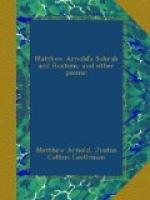[176] THE CHURCH OF BROU
I. THE CASTLE
The church of Brou is actually located in a treeless Burgundian plain, and not in the mountains, as stated by the poet.
=1. Savoy=. A mountainous district in eastern France; formerly one of the divisions of the Sardinian States.
=3. mountain-chalets=. Properly, herdsmen’s huts in the mountains of Switzerland.
=17. prickers=. Men sent into the thickets to start the game.
=35. dais=. Here, a canopy or covering.
=69. erst=. See note, l. 42, The Scholar-Gipsy. ( Formerly. (Obsolete except in poetry.))
=71. chancel=. The part of a church in which the altar is placed.
=72. nave=. See note, ll. 70-76, Epilogue to Lessing’s Laocooen.
=77. palmers=. Wandering religious votaries, especially those who bore branches of palm as a token that they had visited the Holy Land and its sacred places.
=109. fretwork=. Representing open woodwork.
II. THE CHURCH
=17. matin-chime=. Bells for morning worship.
=21. Chambery=. Capital of the department of Savoy Proper, on the Leysse.
=22. Dight=. See l. 277, Sohrab and Rustum. (Adorned, dressed.)
=37. chisell’d broideries=. The carved draperies of the tombs.
III. THE TOMB
=6. transept=. The transversal part of a church edifice, which crosses at right angles between the nave and the choir (the upper portion), thus giving to the building the form of a cross.
=39. foliaged marble forest=. Note the epithet.
[177]
=45. leads=. That is, the leaden roof. See
l. 1, Part II. (Upon the glistening leaden roof).
REQUIESCAT
This poem, one of Arnold’s best-known shorter lyrics, combines with perfect taste, simplicity and elegance, with the truest pathos. It has been said there is not a false note in it.
=13. cabin’d=. Used in the sense of being cramped for space.
=16. vasty=. Spacious, boundless.
What is the significance of strewing on the roses? Why “never a spray of yew”? (See note, l.140, The Scholar-Gipsy.) What seems to be the author’s attitude toward death? (Read his poem, A Wish.) Discuss the poem as to its lyrical qualities.
CONSOLATION
=14. Holy Lassa= (that is, Land of the Divine Intelligence), the capital city of Thibet and residence of the Dalai, or Grand Lama, the pontifical sovereign of Thibet and East Asia. Here is located the great temple of Buddha, a vast square edifice, surmounted by a gilded dome, the temple, together with its precincts, covering an area of many acres. Contiguous to it, on its four sides, are four celebrated monasteries, occupied by four thousand recluses, and resorted to as schools of the Buddhic religion and philosophy. There is, perhaps, no other one place in the world where so much gold is accumulated for superstitious purposes.




